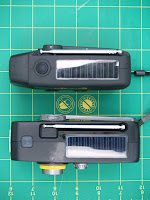 |
|
& is used with permission.
|
I'm looking for a portable radio that can be hand-cranked or use solar power to keep in juice. Listen-only radio, not transmit. Price range $100 or less. Any ideas?Easily done, I said, and I linked him to one of my perennial favorites: an AM/FM/Weather Band flashlight by Etón that uses both a dynamo crank and a solar panel to charge itself. The current version is the FRX2; the model I own is the FR150 (reviewed here) which has since been surpassed by the FR1650, FR170, FRX1, and the current model.
Here is Lawrence's review after buying the FRX2 on my recommendation:
OK, I'm not big on writing reviews but Erin asked me to, so I will. Last week I took a quick two-day camping trip and tested my bug out bag at the same time. In fact, much of my camping gear is part of the bug out kit -- easier that way, and I don't double my efforts. I just have to restock supplies when I got home.It's always a pleasure (and a bit of a relief) to hear that something I recommended performed as advertised and my advisee is happy with the results.
The new tool in my kit, the Eton FRX2 Hand Turbine AM/FM Weather Radio with Smartphone Charger, came when I asked Erin a few weeks back on a recommendation. And I have to say I liked it.
- I charged it up using my laptop as soon as I got it, and the instruction manual said it would run for three hours... it ran for five hours with the speakers at full strength.
- Hand cranking it takes about ten minutes for an hour of power as well.
- Can't gauge solar cells as it sat in the sun a lot.
- Radio reception was clear, and since I was in Cape Henelopen in Delaware for this trip, I took it out to the beach at night to see how far the range was extended (a little trick I learned when I was younger). I got radio stations as far out as Canada and North Carolina.
- My only issue was the the USB cable that came with it wasn't the same type as my cell phone charger, so I had to find my spare for the trip. I left the phone hooked up to the radio while it sat in the sun for two hours and came back to find the phone fully charged and the radio still had plenty of juice to play for another hour before I had to turn it off and let the sun do its job.
Since my main complaint about the FR150 (its inability to charge a smart phone) was apparently solved in later generations, I decided to follow my own advice and purchase an FRX2 for myself. Two is one and one is none, after all, and this way I could see what improvements have been made to the line. Here's the head to head comparison between the two:
- Purchase price is similar, given half a decade's inflation. I recall I bought my FR150 for about $24.99 back in 2009ish; the FRX2 can be bought on Amazon for $31 in 2015.
- The 150 is covered in a rubberized coating that not only makes it easier to grip, it also provides basic rain resistance. The X2 is just slick plastic and the instruction manual says "Do not expose this appliance to rain or moisture." This is actually a very serious shortcoming on the part of the X2 in my opinion.
- The X2 is larger than the 150 in every dimension. Although not massively larger, it is noticeable to me and my small hands. The 150 is sized well for me to hold it comfortably as a flashlight; the X2 is too large for my tastes. The X2 is also "boxier", with more pronounced edges, again making it uncomfortable to hold as a flashlight. The 150 has a more organic shape with comfortable curves and rounded edges, which feels pleasing to my hand. This might not be an issue for folks with larger hands, but it was for me.
- However, this boxiness means that the X2 can stand on its tail to light a room by aiming the flashlight at the ceiling; the 150's curved edge is not as stable and has a tendency to rock and wobble unsteadily.
- Speaking of flashlights, while the X2 has a larger aperture and therefore a larger beam, I believe the lamps are still throwing out the same amount of lumens, as the 150's beam seemed slightly brighter.
- Both had excellent radio reception and clarity of speaker. The X2 seems slightly louder, likely due to it having a larger speaker, but overall the difference is is "not much".
- The biggest difference, however, is with the charger:
- The FR150 will a) not charge a smartphone, and 2) requires turning the crank to charge an electronic device -- the solar cell is only for radio/flashlight operation.
- The FRX2, however, not only charges my iPhone and my Kindle, it does so from the battery -- meaning that I can leave the charger in the sunlight and it will charge independently.

Aesthetics/ergonomics aside, the FRX2 is a fantastic purchase and I wholly recommend it to everyone. My only concern is its apparent inability to tolerate moisture, so if you're planning to use it in a get home or bug out bag, put it in a waterproof container (like a ziploc baggie) to keep it dry.
Other than this serious shortcoming (which I truly hope Etón corrects in later models), I recommend this product to everyone for use.
Etón FRX2: $31.00 + free shipping (Amazon). Highly Recommended.
Have a safe weekend, everyone, and see you next week.
Obligatory FTC Disclaimer: I bought this with my own money. (So did Lawrence.) Go away.





























